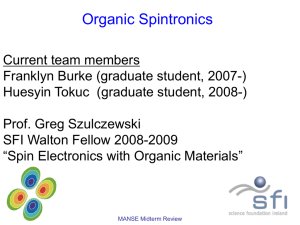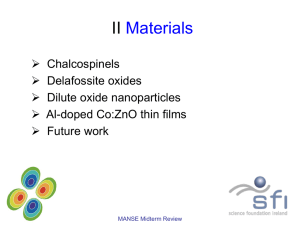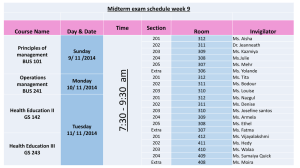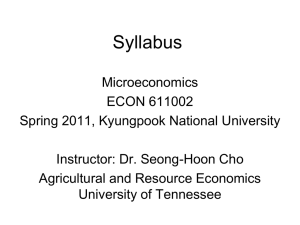MANSE Midterm Presen..
advertisement
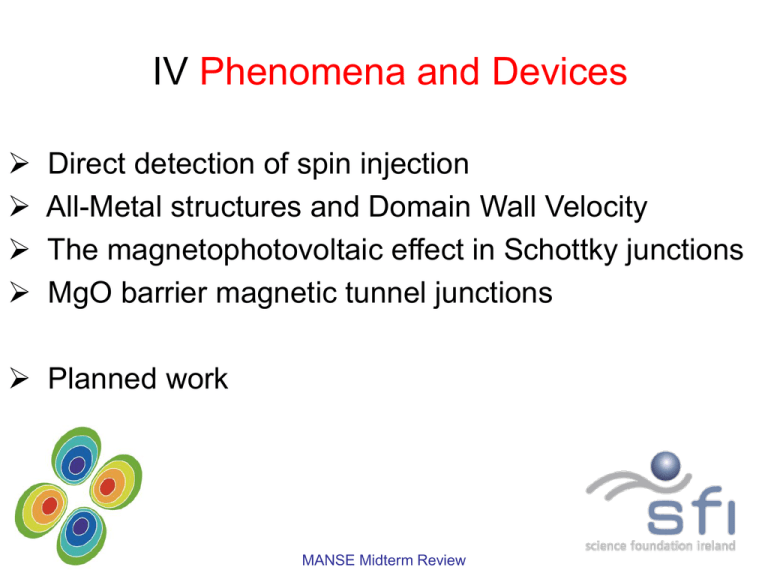
IV Phenomena and Devices Direct detection of spin injection All-Metal structures and Domain Wall Velocity The magnetophotovoltaic effect in Schottky junctions MgO barrier magnetic tunnel junctions Planned work MANSE Midterm Review Staff, Publications • • • • • • • Plamen Stamenov Postdoc from November 2007 Huseyin Kurth Postdoc Tomohiko Niizeki Postdoc Gen Feng Postdoc Ciaran Fowley Postgrad Cathy Boothman Postgrad Kaan Oguz Postgrad MANSE Midterm Review Publications; — On the direct magnetic detection of spin injection and adiabatic depolarisation in aluminium, P. Stamenov and JMD Coey, Journal of Magnetism and Magnetic Materials, 320, 403-406 (2008) —Influence of annealing on the bias voltage dependence of tunnelling magnetoresistance in MgO double-barrier magnetic tunnel junctions with CoFeB electrodes, G Feng, S van Dijken and J.M.D. Coey, Applied Physics Letters 89 162501 (2006) —Effect of barrier sputtering parameters on Co80 Fe10 B10 – MgO magnetic tunnel junctions G. Feng, S. van Dijken and J. M. D. Coey, J. Magnetism Magnetic Materials 316 E984-986 (2007) —Noise in MgO barrier magnetic tunnel junctions with CoFeB electrodes; influence of annealing temperature, J. Scola, H Polovy, C. Fermon, M. Pannetier-Lecoeur, G. Feng, K. Fahy and J. M. D. Coey, Applied Physics Letters 90 252501 (2007) —High inverted tunneling magnetoresistance in MgO –based magnetic tunnel juctions, J. F. Feng, Gen Feng, J. M. D. Coey, X.F. Han, and W.S. Zhan. Applied Physics Letters 91 102505 (2007) — Room-temperature magnetoresistance in CoFeB/STO/CoFeB magnetic tunnel junctions, K. Oguz and J. M. D. Coey, Journal of Magnetism and Magnetic Materials, (2008) — Magnetic annealing of CoFeB/MgO based single and double tunnel junctions: tunnel magnetoresistance, bias dependence and output voltage, G. Feng, S. van Dijken, J.M.D. Coey, T. Loo and D.J. Smith. Journal of Applied Physics, 105 (2009) in press MANSE Midterm Review — An approach to fabricate pure metallic Ni-Ni and metallic oxide Ni-NiO-Ni nanocontacts by a repeatable microfabrication method, H X Wei, T. X. Wang, H. Wang, X. F. Han, M. A. Bari and J. M. D. Coey, International Journal of Nanotechnology 4 21-31 (2007) — Magnetoresistance in NiOx nanoconstrictions controlled by magnetic fields and currents, O.Cespedes, M. Viret, JMD Coey, Journal of Applied Physics, 103, 083901 (2008) — Size-dependent scaling of perpendicular exchange bias in magnetic nanostructures, G Malinowski, M. Albrecht, I. L. Guhr, J. M. D. Coey and S. van Dijken, Phys. Rev. B 75 012423 (2007) — Reply to Comment on ‘Size-dependent scaling of perpendicular exchange bias in magnetic nanostructures’ , G. Malinowski, M. Albrecht, I.L. Guhr, J.M.D. Coey. S. van Dijken, Physical Review B 77 017402 (2008) — Magnetic dead layers in sputtered Co40Fe40B20 films, K. Oguz, P. Jivrajka, M.Venkatesan, G. Feng, J.M.D. Coey, Journal of Applied Physics, 103, 07B526 (2008) — Point contact Andreev reflection by nanoindentation of polymethyl methacrylate, E. Clifford and J. M. D. Coey, Applied Physics Letters 89, 092506 (2006) MANSE Midterm Review Introduction Junctions & Devices Metallic Structures (Non GMR) Direct Spin Injection Detection Anomalous Magnetoresistance Structures (In-plane Anisotropy) Spontaneous Hall Effect Structures & Metal-Semiconductor Contacts Magnetic Field Effects Theory & Experiment Large Area Junctions Electronic & Magnetic Response Sensors (Linear Response) Low Barrier Height Junctions for Spin Injection Perpendicular Anisotropy & Domain Wall Velocity GMR and TMR Junctions Small Area Junctions MANSE Midterm Review Field & Current Driven Switching Oscillatory & High Frequency Response Spin Injection – Spin-Self-Diffusion P ˆ P ˆ P ˆ D 2 A CP 0 t z z z P P0 exp( ) 2 s s D sf sf 0 MANSE Midterm Review Hence the spin diffusion length is much greater than the mean free path. Direct Measurement of Injected Polarisation 2 cm Au H, M Al η Fe,Co, Ni, Zn Au Al Injector +I straw z axis λs z Z Point spread function for single dipole at z 1.5 10 10 rc 1 10 10 Φ(Wb) vy k vy lin l 5 10 11 Line j X 0.04 0.03 0.02 0.01 0 5 10 0.01 0.02 0.03 0.04 Y+ + - •Using a commercial second-order gradiometer system 11 z (m) vx vx lin m k l j 1 • The magnetic background of the injectors is a major concern MANSE Midterm Review Magnetisation Profile Theory & Experiment 6 13 p ferro R ti Rr i i 2 Injected moment for positive electronic current Fe moment 2 pr paraR t 1 i R l i 0.5 i 2 pl para R l Ri r i i 0 0 1 4 Rr i 2 Rl i R i 0 0 λs=0.35 cm 2 0 24 3 4 2 3 1 2 1 z 0 0 z (cm) iz 1 2 3 4 1 2 3 4 4 3 2 right injection 1 2 3 4 Fe @ 100 mT, 1.8 K 3.0 2.5 Rp i Raw Voltage USQUID(V) Rr i 0 Rl i R pl i R pr i 0 z (cm) i 3 1 0 1 z i left injection 4 Rt i 2 +15 mA -15 mA 0 mA 0 mA 2 2.0 1.5 1 Rt i1.0 2 0.5 0 R l R r 0.0 i i 1 0 depolarization Rd i -0.5 1 -1.0 paramagnetism -1.5 2 4 -2.0 2 0 4 3 2 1 0 z i 1 2 3 4 3 1 2 2 1 3 0 z Position i(cm) 4 •The injected magnetisation is small even for 100 % efficiency MANSE Midterm Review 1 5 2 6 3 7 4 8 Why should it work? / Why should it not? • • • • • • Long spin diffusion length – 3 nm (300 K) 300 μm (20 K) ~ 3 mm (2 K) High polarisation of ferromagnetic injectors – 40 % Signal magnitude – Zeeman shift of electrochemical potential is 0.1 meV/T, Spin injection shift 1 eVm/V (10-2 V/m achievable → ~ 10 meV) Spatial discrimination – fully decorrelated at 1 cm Short timescales (10 – 100 ns) – audio frequency modulation is possible Complications arising from injector stability and superconducting transitions (Al, In) are avoidable • • • • • • • • • • • • Small signals moments of ~ 10-9 Am2 Small injection efficiencies ~ 5 % Large background – 10 times the signal Background drifts – up to 100 %/min High power dissipation levels – 10 mW/cm Parasitic inductive pickup – angular errors of 0.3 mm/10 cm – antisymmetric with respect to current Signal and noise spatial frequency spectrum overlap Unexpected effects, symmetric with respect to current … 1985 M. Johnson and R. H. Silsbee – electrical detection of the “Hanle Effect” 1993 M. Johnson – spin accumulation in Au … MANSE Midterm Review Various Aspects of the Observed Effects 2 0.00002 0.00001 0.00000 -0.00001 -0.00002 antisymmetric, ± H -0.00003 1.6 1.4 8 3 0.00003 Abs. Symmetric Response S x 10 , Am 2 0.00004 Scaled Response x 10 Am symmetric, - H 0 mA bkgnd H+ 10 mA asym H+ 10 mA sym H + 0 mA bkgnd H 10 mA asym H 10 mA sym H - 1.2 1.0 0.8 0.6 0.4 0.2 0.0 -0.2 -0.00004 0 1 2 3 4 5 Position (cm) 6 7 2 10 100 Temperarure T, K symmetric, + H Symmetries of the Effects Temperature Dependence 12 10 AC Out of Phase Amplitude Linear Fit 10000 antisymmetric (mutual inductance) symmetric (heating, injection ...) 8 Peak Magnetic Moment Density mz x 10 , Am 1 8 8000 Magnitude (a. u.) 8 6 4 6000 4000 2000 2 0 0 0 5 10 15 20 25 30 35 0 40 Current Amplitude IDC, mA 20 40 60 80 100 Magnetic Field (mT) Current Dependence Field Dependence MANSE Midterm Review 0.4 10 Scaled current response x 10 , Am 2 AC rod sample - Fe @ 1.8 K, 20 mT 0.0 -0.4 -0.8 Zero bias Positive bias Negative bias -1.2 0 2 4 6 8 Position (cm) cross-induction • Only cross-induction from the injection electrodes is observable MANSE Midterm Review Spin Injection Conclusions • No spin injection or adiabatic electronic heating down to δM of the order of 1 A/m, current densities of 108 A/m2 and fields up to 0.5 T • Non-trivial current, field and temperature dependencies for most observed effects • Further work on custom-designed gradiometers MANSE Midterm Review AHE Sample, Setup and Specs ~ 100 mA 2 kΩ 40 dB -100 dBV V 20 kΩ -100 dB ± 1.2 T 40 dB V 60 dB Real-Time Digital Oscilloscope • • • • • • • • • • • Spontaneous (Anomalous) Hall [Pt1/Co0.5]3Pt2 [Pt1/Co0.5]3IrMn10Pt2 Size (0.1 – 0.3) x (10 - 500 μm) DC – 50 MHz broadband AC – 1-10 MHz LIA Bmax = 200 mT, 1.2 T, 14 T dB/dT = 200 T/s, 0.5 T/s, 13 mT/s 2 K < T < 350 K I max < 100 μA VDW < 1000 m/s MANSE Midterm Review CoFe/Pt Domain Topology 2 μm, 5 μm 1 μm, 2 μm 500 nm, 1 μ m MANSE Midterm Review 400 nm, 500 nm 200 nm, 200 nm M,UAHE vs μoH without Exchange Bias T = 300 K AHE Voltage (V) 6 Top Cross 5 4 3 2 1 7 5 4 3 2 4 -7 3 Bottom Cross 2 1 0 -1 -2 -3 -0.20 -0.15 -0.10 -0.05 0.00 0.05 0.10 0.15 -8 Bottom Cross -9 -10 -11 -12 -13 -0.20 0.20 Top Cross 6 0 AHE Voltage (V) AHE Voltage (V) AHE Voltage (V) 7 -0.15 Magnetic Field (T) • • • Symmetric with ± B Reversal through multiple domain states, NOT a single nucleationpropagation event DC Bias offsets -0.10 -0.05 0.00 0.05 0.10 0.15 0.20 Magnetic Field (T) • • • • Asymmetric with ± B Reversal may be through a single nucleationpropagation event Advantageous to come back from the EB direction Opposite EB directions on the two crosses MANSE Midterm Review Example without Exchange Bias • Independent reversal at the two crosses • Field-sweep-rate determined time delay • Large number of events • Small induction effects 10 AHE Voltage (V) 5 0 Bottom Cross Top Cross Bottom Filtered Top Filtered -5 -10 -15 -0.4 -0.3 -0.2 -0.1 0.0 0.1 0.2 Time (s) MANSE Midterm Review Example with Exchange Bias • Correlated reversal on the two crosses • Field-sweep-rate independent time delay • Small number of evens • Negligible induction effects AHE Voltage (V) 8 6 4 2 0 Top Cross Bottom Cross -2 Filtered AHE Voltage (V) -4 7 6 5 4 3 2 1 0 -1 -2 -3 -4 -0.02 Top Cross Bottom Cross -0.01 0.00 0.01 0.02 0.03 Time (s) MANSE Midterm Review 0.04 Schottky Barriers Current Components a) Thermionic emission over the barrier b) Tunneling through the barrier c) Recombination in the space-charge region d) Recombination in the neutral region After: Rhoderick, E.H. & Williams, R.H. (1988). Metal-Semiconductor Contacts. Oxford: Clarendon. MANSE Midterm Review Schottky Barriers Simple Models The Schottky Model q 2 Dn Nc Jn kT 2q(b Va ) N d s qb qVa exp exp 1 kT kT The Bethe Model 4 qmc*k 2 2 qb qVa Jn T exp exp 1 3 h kT kT The Sze Model qNc vr qb qVa Jn exp exp 1 vr kT kT 1 vd MANSE Midterm Review Schottky Barriers Effective Circuit Rl Cj +Out -Out Rr Rs Ddd Dti Schottky Junction • The far from simple effective circuit of the real diode makes the analysis of all possible magnetic field effects difficult • The extraction of spin polarisation information is, by necessity, model dependent MANSE Midterm Review Schottky Barriers Magnetic Field Effects g m B B Thermionic-emission: MC metal kT c gs B B semiconductor MC s kT gs B B MC s Drift-diffusion: 2qb * 2 Va r Ambipolar diffusion: MC ( ) B 2 xd c m Recombination: ( g c g v ) B B MC 2kT MANSE Midterm Review CoFe1 CoFe2 0.008 0.006 0.004 0.002 0.000 -4 -2 0 2 CoFe 0.0005 Difference in Differential Conductances OUT - IN Differantial Conductance s , S Schottky Barriers Derivative Spectroscopy CoFe/Si<111> 4 0.0 0.5 1.0 1.5 2.0 2.5 3.0 3.5 4.0 4.5 5.0 5.5 0.0000 -0.0005 -0.0010 -0.0015 -0.0020 -0.0025 -6 -4 -2 0 2 4 6 4 5 Voltage U, V 0.7 0.5 T 1T 1.5 T 2T 2.5 T 3T 3.5 T 4T 4.5 T 5T 5.5 T 0.6 0.000 Derivative Deviation (mVRMS) Difference in Differantial Conductance Voltage U, V -0.001 -0.002 0.5 0.4 0.3 0.2 0.1 0.0 -0.1 -0.2 -0.3 -0.4 -0.003 -5 -4 -3 -2 -1 0 1 2 3 4 5 -1 0 1 2 3 Voltage Bias UDC, V Voltage U, V MANSE Midterm Review T T T T T T T T T T T T 0.013 0.012 Cu Cu1 Cu2 0.011 0.0022 Difference in Differential Conductances OUT - IN Differantial Conductance s , S Schottky Barriers Derivative Spectroscopy Cu/Si <111> 0.010 0.009 0.008 0.007 0.006 0.005 0.004 0.003 0.002 0.001 0.000 -5 -4 -3 -2 -1 0 1 2 3 4 0.0 0.5 1.0 1.5 2.0 2.5 3.0 3.5 4.0 4.5 5.0 5.5 0.0020 0.0018 0.0016 0.0014 0.0012 0.0010 0.0008 0.0006 0.0004 0.0002 -6 5 -4 -2 Voltage U, V 2 4 6 0.14 0.006 0.12 Derivative Deviation (mVRMS) Difference in Differential Conductances 0 Voltage U, V 0.005 0.004 0.003 0.002 0.001 0.10 0.08 0.06 0.04 0.02 0.00 -0.02 0.5 T 1T 1.5 T 2T 2.5 T 3T 3.5 T 4T 4.5 T 5T 5.5 T -0.04 -0.06 -0.08 -0.10 -0.12 -0.14 -0.16 0.000 -5 -4 -3 -2 -1 0 1 2 3 4 5 -5 -4 -3 -2 -1 0 1 Voltage Bias UDC, V Voltage U, V MANSE Midterm Review 2 3 4 5 T T T T T T T T T T T T Schottky Barriers Photo-illumination metal +++ semiconductor front illmination back illumination (1) 0 h I0 h I0 ohmic contact h I --- Ec EF (2) A Ev d V metal semiconductor • Illumination eliminates the need for external biasing Iaux Iph • The contribution of the series magneto-resistance of the diode base is strongly diminished D Rs V (a) MANSE Midterm Review Rs D V (b) Schottky Barrier Magneto-Photo-Voltaic Effect ? 0.50 AuSi @ 61 K 0.45 b lim VOC (h ) 0.40 Photovoltage Uph, V 0.35 I g* ( ) 0 CoSi @ 61 K 0.30 0.25 0.20 AuSi @ 300 K b lim VOC ( I ) 0.15 I ,T 0 0.10 CoSi @ 300 K 0.05 0.00 0 10 20 30 40 50 60 70 80 90 100 Light Intensity I, % • The photo-voltage does saturate as a function of the illumination light intensity at sufficiently low temperatures • The photo-voltage does become a good measure of the barrier height and can be used to extract spin polarisation MANSE Midterm Review Schottky Barriers Magneto-Photo-Voltaic Effect 5 6 Magneto-Photo-Voltaic Effect MPV, % 100 K Magneto-Photo-Voltaic Effect MPV, % 5 0 -5 -10 MPV % / T @ T = 100 K Co 0.33(1) Au 0.024(4) Fe -1.23(4) Ag 0.12(1) -15 4 3 2 1 0 200 K -1 -2 -3 -4 MPV % / T @ T = 200 K Co 0.126(8) Au 0.014(9) Fe -0.512(8) Ag 0.377(6) -5 -6 -7 -8 -9 0 2 4 6 8 10 12 14 0 2 Magnetic Field 0H, T Metal / Si (% / T) 100K 4 6 8 10 12 14 Magnetic Field 0H, T (% / T) 200 K α (%) 100 K α (%) 200 K Co +0.33 +0.13 +25 +19 Fe -1.23 -0.15 -91 -76 Au +0.02 +0.01 +3 +2 Ag +0.12 +0.37 +8 +55 MANSE Midterm Review Schottky Barriers Photovoltaic Measurements • The Schottky barrier height should be sufficiently different from the band-gap of the semiconductor, to avail for experimental separation of the internal photoemission • The metal layer should be sufficiently transparent at the frequencies of interest, but sufficiently thick to preserve bulk behaviour • The temperature dependence of the Schottky barrier height should be sufficiently weak • The Schottky barrier height should be determined by the difference of the work functions of the two materials and not by interface pinning MANSE Midterm Review R3D – GdCo2 5.4 Ni Electron work function , eV 5.2 Co 5.0 4.8 Cu Cr 4.6 Ti 4.4 Fe V 4.2 Mn 4.0 Zn 3.8 Sc 3.6 3.4 20 21 22 23 24 25 26 27 28 29 30 31 Atomic number Z -20 10 o Y annealed at 1000 C R0 = 10.9 ln (I0.2 V) Current (mA) 5 0 -30 GdCo2 -40 0.641(2) eV 0.192(3) eV -50 -60 -70 -5 -80 -90 -10 -0.10 -0.05 0.00 Voltage (V) 0.05 0.10 0.000 0.005 0.010 0.015 0.020 Inverse Temperature 1/T, 1/K MANSE Midterm Review 0.025 0.030 MTJ Optimisation MANSE Midterm Review Tunnel Junction Fabrication 1 ) Bottom contact patterning: UV lithography + 45o Ar+ Ion Milling 4) Lift off: Ar+ Ion Milling (5o) + Hot Ultrasonic for 5-6 hours in remover 2) Pillar patterning: E-Beam lithography + Ar+ Ion Milling (85o + 5o) 5) Top Contact deposition: UV lithography + Sputtering (Ta5/Cu100nm) + lift off 3) Sputtering SiO2 Deposition (100 nm) MTJ stack Ebeam Resist SiO2 Cu contact MANSE Midterm Review Tunnel Junctions Derivative Spectroscopy V(J, H) θ=0o dV/dJ(J, H) J H θ=0o d2V/dJ2(J, H) J H θ=0o J Annealed H As Deposited MANSE Midterm Review Tunnel Barriers Magneto-conductance 1.0 1.0 -barrier 0.5 0.5 0.0 MC MC(Va) 0.0 -0.5 -1.0 -0.5 EF/q -1.5 -1.0 -2 -1 0 1 2 -2.0 0.0 qVa/EF Delta barrier 0.1 0.2 0.3 Va (V) Realistic adiabatic barriers MANSE Midterm Review 0.4 0.1 V 0.2 V 0.3 V 0.5 0.4 V 0.5 V Tunnel Junctions Micromagnetic Effects 90 16 12 10 2 Parameters: off = 4.970(6) mV A = 8.51(2) mV Ha = 315(1) mT 8 Field (mT) 200 100 50 20 10 5 2 1 < 0.5 60 12 + A cos[atan(H / Ha)] 10 120 o 14 Model: Vac = off + Derivative Voltage (mV) Derivative Voltage (mV) 14 = 20 2 R = 0.9995 6 30 150 8 6 4 2 0 180 0 2 4 6 8 330 210 10 12 4 -3 -2 -1 0 1 2 3 14 240 16 Magnetic Field 0H, T 300 270 Conventional magnetisation reversal process in exchange biased junction Small angle deviations of the electrodes MANSE Midterm Review Tunnel Junctions The High Field Limit 0.014 Deriative Voltage (V) 0.013 14 T 10 T 7T 5T 2T 1T 0.5 T CoFeB Annealed Field Out Of Plane 0.012 0.011 0.010 0.009 0.008 0.007 0.006 0.005 0 25 50 75 100 125 150 175 200 225 250 275 300 325 350 Angle , deg Is there any detail in the high field limit, when the magnetisations of junction electrodes are aligned parallel to each other and to the applied field? MANSE Midterm Review Tunnel Barriers High Field TAMR? 0o 0o 10 T 14 T 10 T Angle θ Angle θ Annealed 360 o 360 o 0o 0o 7T D iffSRegBin T Angle θ T D iffSRegBin 5T 7T Angle θ T 5T T D iffSRegBin D iffSRegBin 360 o 360 o -0.5 Applied Voltage (V) +0.5 -0.5 V Applied Voltage (V) As deposited 14 T -0.5 +0.5 Applied Voltage (V) +0.5 -0.5 Applied Voltage (V) +0.5 • Detail appears in the derivative spectra only after the constant derivative background hasD iffSRegBin been subtracted D iffSRegBin D iffSRegBin D iffSRegBin • The symmetry of the effect is high and one base function should be sufficient to describe it • Unannealed junctions show at least three times lower amplitudes T T T MANSE Midterm Review T Tunnel Barriers TAMR Base Function? Annealed T=2K Annealed T = 10 K Unannealed T=2K Unannealed T = 10 K Difference Voltage (V) 25 0 14 T 10 T 7T 5T 25 0 -100 -50 0 50 -50 Current (A) MANSE Midterm Review 0 50 100 Tunnel Barriers TAMR Fit? 14 T 2 K Total Peak 1 Peak 2 Peak 3 Peak 4 Peak 5 Peak 6 30 2K Difference Voltage (V) 25 20 15 10 5 0 30 20 15 10 0 -5 -10 -10 -15 -0.6 -0.4 -0.2 0.0 0.2 0.4 0.6 0.8 10 K 5 -5 -15 -0.8 5 T 10 K Total Peak 1 Peak 2 Peak 3 Peak 4 Peak 5 25 Difference Voltage (V) 35 -20 -0.8 -0.6 DC Bias (V) -0.4 -0.2 0.0 0.2 0.4 0.6 0.8 DC Bias (V) • The fit is a set of four Lorentzians of width 0.35 eV and approximately equivalent spacing of 0.25 eV, corresponding to the anisotropy of both spin-up and spin-down bands near the Fermi surface. MANSE Midterm Review Tunnel Barriers No Effect in the Plane 0.5 T 1.0 T 14.0 T 0o 360 o -0.7 V +0.7 V -0.7 V +0.7 V -0.7 V +0.7 V • One privileged direction only – after crystallization direction and the T• The angle between T T the electron propagation egBin D iffSRegBin D iffSRegBin magnetisation remains constant • Micromagnetic effects tend to dominate the low field transport • Directional anisotropy is obvious – exchange bias MANSE Midterm Review Current Driven Switching TMR Junctions Nano-pillar x = 100 nm y = 200 nm R TMR 40 1200 RA = 18 m 1000 20 2 0 -150 -100 -50 0 50 100 150 200 80 1400 60 1200 40 1000 20 0 800 -1.0 -0.5 0.0 External Magnetic Field (mT) -20 1.0 0.5 Current (mA) 1.0 HEB , Hext, Hd 0.5 Mfree 120 100 Voltage (V) 800 -200 0H = 5 mT x 0.0 -0.5 -1.0 -1.0 -0.5 0.0 Current (mA) MANSE Midterm Review 0.5 1.0 TMR (%) 1400 TMR (%) 60 Resistance TMR 1600 80 1600 140 1800 100 1800 Resistance () 120 Resistance () 2000 Tunnel Junctions Conclusions • Well characterized tunnel junctions with high TMR, good patterning and well-behaved micromagnetically • There is high field anisotropy of the tunnelling magnetoresistance • Origin is the anisotropy of the electronic structure • The fundamental reason is spin-orbit coupling MANSE Midterm Review Sensors (Linear Response) GMR Junctions Ta5/CoFe1.5/Cu2.8/ CoFeX / RuY / CoFeZ /Cu2.8/CoFe2.5/IrMn10/Ta5 10 X = 1.0, Y = 0.8, Z = 1.6 X = 1.6, Y = 0.8, Z = 1.0 8 Magnteoresistance (%) GMR Ratio (%) 8 6 4 2 6 4 2 0 -2 SAF Moment Maintained -4 0 -80 -40 0 40 80 -100 -50 0 50 100 H (Field (mT)) Field (mT) • Reversal behaviour typical of exchange-biased spin-valves • It is possible to engineer structures where the SAF looses magnetic integrity at small external fields, therefore resulting in negative GMR ratios MANSE Midterm Review Sensors (Linear Response) TMR Junctions 35 400 R TMR 380 30 25 ~ 6 /mT ~ 2 %/mT Nominal Res. ~ 340 Linear Region ~ 8.5 mT Centered at ~ 6 mT 340 20 15 10 320 5 300 -200 Nano-pillar x = 209 nm, y=122 nm -150 -100 -50 0 0 50 100 External Magnetic Field (mT) HEB Mfree Hext, Hd MANSE Midterm Review 150 200 TMR (%) Resistance () Max. Slope 360 Oscillatory & High Frequency Response 5.0 Bias T 4 GHz 4.5 GHz 4.0 Device Detected DC Voltage (V) 4.5 3.5 3.0 2.5 5 GHz 2.0 MW Source Idc 1.5 1.0 0.5 450 0.0 0 100 200 300 400 500 400 H (Oe) -6 3.5x10 350 -6 3.0x10 300 2.5x10 H (Oe) Induced DC Voltage (V) -6 -6 2.0x10 250 200 -6 150 -6 100 1.5x10 1.0x10 50 -7 5.0x10 0 3 0.0 4 5 6 7 Microwave Frequency (GHz) 0 5 10 15 Input Microwave Power (mW) 20 MANSE Midterm Review 8 Conclusions Direct detection of spin injection will require materials with long spin diffusion lengths > 10 μm and optimized gradiometer assemblies Technology of fabricating and nanoscale pattering of MgO barrier magnetic tunnel junctions has been mastered. Installation of CMP in Spring 2009 will improve yield Optimized low-barrier height Schottky contacts still deserve a detailed investigation as spin-injectors Working thin film stacks and devices based on charge transfer ferromagnetism has yet to be demonstrated MANSE Midterm Review Future work Noise setup Stripline setup High resolution planar and volume GQUID gradiometers Electric field gated spin electroinic devices MANSE Midterm Review Outline MANSE Midterm Review
